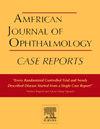替奈普酶逆转缺血性皮质盲
Q3 Medicine
引用次数: 0
摘要
目的:tenecteplase (TNK)是阿替普酶的生物工程变体,具有较长的半衰期、较高的纤维蛋白结合特异性和较低的全身纤溶活性影响。我们报告了一例可逆性双侧视力丧失,同义性偏盲经TNK治疗后。病例描述:一名56岁非裔美国男性,表现为双眼无光觉(NLP)、左半瘫、感觉减退和音感障碍。脑MRI显示急性梗死累及右侧大脑后动脉分布,无出血转化迹象。CTA显示右侧P2 PCA有4mm长节段闭塞。患者在出现症状后2个半小时后静脉注射23mg TNK,视力从NLP OU恢复到20/25 OU,但左侧残留同义性偏盲(HH),左侧偏瘫,感觉下降。患者最终出院接受康复治疗和门诊随访。随访2个月,患者仅剩残余HH。结论及重要性临床医生应了解急性缺血相关性皮质性视力丧失的各种治疗方案,如TNK。未来的医生还应在患者接受TNK前后增加全面的眼科检查,以确定我们的病例是否具有普遍性。本文章由计算机程序翻译,如有差异,请以英文原文为准。
Reversal of ischemic cortical blindness with tenecteplase
Purpose
Tenecteplase (TNK) is a bioengineered variant of alteplase that has a longer half-life, a higher fibrin binding specificity, and a lower effect on systemic fibrinolytic activity. We reported a case of reversible bilateral vision loss to homonymous hemianopsia after TNK administration.
Case description
A 56-year-old African American male presented with acute onset of visual loss to no light perception (NLP) in both eyes (OU), left hemiparesis, decreased sensation, and dysarthria. Brain MRI revealed acute infarct involving the right posterior cerebral artery distribution without evidence of hemorrhagic transformation. CTA showed 4mm long segmental occlusion on the right P2 PCA. After the patient was given intravenous 23mg TNK after two and half hours since symptom onset, he recovered vision from NLP OU to 20/25 OU, but he had a residual left homonymous hemianopsia (HH), in addition to hemiparesis and decreased sensation on the left. The patient was eventually discharged to rehabilitation and outpatient follow up.
At the two-month follow up, patient only had residual left HH.
Conclusions and importance
Clinicians should be aware of the various treatment options in acute ischemia related cortical visual loss such as TNK. Future providers should also add comprehensive ophthalmological exam before and after patient receiving TNK to determine if our case is generalizable.
求助全文
通过发布文献求助,成功后即可免费获取论文全文。
去求助
来源期刊

American Journal of Ophthalmology Case Reports
Medicine-Ophthalmology
CiteScore
2.40
自引率
0.00%
发文量
513
审稿时长
16 weeks
期刊介绍:
The American Journal of Ophthalmology Case Reports is a peer-reviewed, scientific publication that welcomes the submission of original, previously unpublished case report manuscripts directed to ophthalmologists and visual science specialists. The cases shall be challenging and stimulating but shall also be presented in an educational format to engage the readers as if they are working alongside with the caring clinician scientists to manage the patients. Submissions shall be clear, concise, and well-documented reports. Brief reports and case series submissions on specific themes are also very welcome.
 求助内容:
求助内容: 应助结果提醒方式:
应助结果提醒方式:


